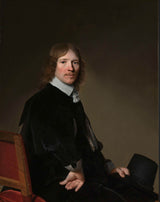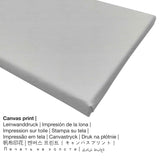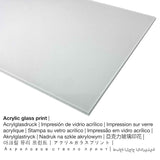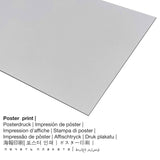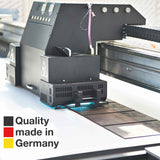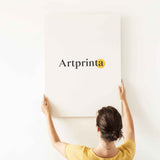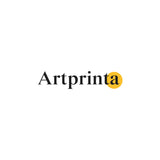Johannes Cornelisz Verspronck, 1652 - Eserese Eduard Wallis - mbipụta nka mara mma.
Ụtụ gụnyere. Mbupu gbakọrọ na ndenye ọpụpụ.
Ngwaahịa nka
a nka ochie artpiece was created by Johannes Cornelisz Verspronck in 1652. It is in the the Rijksmuseum's nchịkọta ihe osise dijitalụ, nke bụ ihe ngosi nka kacha ukwuu maka nka na akụkọ Dutch site na Middle Ages ruo ugbu a. Site n'ikike nke Rijksmuseum (ọha na eze).: . Further, the alignment of the digital reproduction is in portrait format with an aspect ratio of 3: 4, nke pụtara na ogologo bụ 25% mkpụmkpụ karịa obosara.
Nkọwa nka sitere na Rijksmuseum (© nwebiisinka - Rijksmuseum - Rijksmuseum)
Johannes Verspronck and Frans Hals were active as portraitists in Haarlem around the same time. Yet it is difficult to imagine greater differences between their styles! Verspronck painted smoothly and precisely and lavished attention on detail. Hals’s handling is much sketchier, and his rendering of details much more summary. The wealthy cloth merchant Eduard Wallis and his wife evidently preferred Verspronck.
Nkọwa nka ahaziri
| Aha ọrụ nka: | "Portrait of Eduard Wallis" |
| Nhazi nka: | sere |
| Okwu mkpokọta: | nka ochie |
| Nhazi oge: | 17th narị afọ |
| Emepụtara n'afọ: | 1652 |
| Ogologo afọ nka nka: | 360 afọ |
| Egosiputara na: | Rijksmuseum |
| Ebe ngosi nka: | Amsterdam, Netherlands |
| Weebụsaịtị nke ihe ngosi nka: | Rijksmuseum |
| Akwụkwọ ikike nka: | ngalaba ọha |
| Site n'aka: | Rijksmuseum |
Banyere onye na-ese ihe
| Aha onye nka: | Johannes Cornelisz Verspronck |
| okike onye nka: | nwoke |
| Obodo onye nka: | Dutch |
| Ọrụ: | onye na-ese ihe |
| Country: | mba netherland |
| nhazi ọkwa: | nna ukwu ochie |
| Nwụrụ anwụ: | 59 afọ |
| Afọ ọmụmụ: | 1603 |
| Ebe amụrụ onye: | Haarlem |
| Nwụrụ n'afọ: | 1662 |
| Ebe ọnwụ: | Haarlem |
Kedu ihe ga-amasị gị mma ebipụta nka nka?
Maka ngwaahịa ọ bụla anyị na-enye ụdị nha & ihe dị iche iche. Họrọ n'ime nhọrọ ngwaahịa ndị a ugbu a ka ị kwekọọ na mmasị gị na nha na akụrụngwa:
- Bipụta na iko acrylic na-egbuke egbuke (nke nwere ezigbo mkpuchi iko): A glossy acrylic glass print, often referenced as a fine art print on plexiglass, makes the original into magnificient décor. Furthermore, it is a distinct alternative option to dibond and canvas art prints. Your work of art is being made thanks to the help of state-of-the-art UV direct printing technology. With an acrylic glass art print contrasts and small artwork details will be more recognizeable thanks to the precise gradation. Our plexiglass protects your custom art print against light and external influences for many decades.
- Mbipụta nke aluminom: An Aluminium Dibond print is a print with a true depth, which creates a contemporary look by having a surface structure, which is not reflective. A direct Direct Print on Aluminum Dibond is the best start to fine art prints on aluminum. The white & bright components of the original artwork shine with a silky gloss, however without any glow. Colors are luminous, the details of the print are very clear, and the print has a a matte appearance you can literally feel. This direct print on aluminium is one of the most popular entry-level products and is a contemporary way to display artworks, since it puts 100% of the viewer’s focus on the image.
- Ebipụta akwụkwọ mmado na ihe akwa akwa: Our poster is a UV printed flat canvas paper with a granular finish on the surface, that reminds the actual version of the masterpiece. Please bear in mind, that depending on the size of the poster we add a white margin 2-6 cm around the print motif to facilitate the framing.
- Mbipụta kwaaji: A printed canvas, which shall not be mistaken with a real painting on a canvas, is a digital copy printed from an industrial printer. A printed canvas of your favorite masterpiece will provide you with the unique opportunity of transforming your into a large artpiece like you would see in a gallery. The great advantage of canvas prints is that they are relatively low in weight, which implies that it is quite simple to hang the Canvas print without extra wall-mounts. Therefore, canvas prints are suited for any kind of wall.
Banyere ihe a
| Nkewa edemede: | ọmarịcha nka |
| Mmeputakwa: | dijitalụ mmeputakwa |
| Usoro mmepụta: | Mbipụta UV ozugbo (mbipụta dijitalụ) |
| Nlụpụta: | Germany |
| Ụdị ngwaahịa: | mmepụta ihe na-achọ |
| Ihe eji eme atụmatụ: | mkpokọta nka (mmeputakwa), mgbidi gallery |
| Nhazi onyonyo: | usoro eserese |
| Ụdị anya: | 3:4- (ogologo: obosara) |
| Nkọwa nke oke akụkụ: | ogologo bụ 25% mkpụmkpụ karịa obosara |
| Nhọrọ dị: | mbipụta ọla (aluminium dibond), mbipụta akwụkwọ mmado (akwụkwọ kwaaji), mbipụta kanvas, mbipụta iko acrylic (nwere ezigbo mkpuchi iko) |
| Nhọrọ nha nke akwa akwa n'elu etiti ihe na-agbatị (mbipụta kwaaji): | 30x40cm - 12x16", 60x80cm - 24x31", 90x120cm - 35x47", 120x160cm - 47x63" |
| Mbipụta iko acrylic (nwere ezigbo mkpuchi iko) nhọrọ nha: | 30x40cm - 12x16", 60x80cm - 24x31", 90x120cm - 35x47" |
| Mpempe akwụkwọ mmado (akwụkwọ kwaaji) nha dị iche iche: | 30x40cm - 12x16", 60x80cm - 24x31", 90x120cm - 35x47" |
| Mbipụta aluminom (aluminium dibond ihe) dị iche iche: | 30x40cm - 12x16", 60x80cm - 24x31", 90x120cm - 35x47" |
| Nhazi nke nka nka: | enweghị etiti |
Nkwupụta iwu: We try everything to describe the art products with as many details as we can and to exhibit them visually. Nevertheless, the colors of the printing material and the print result can diverge somehwat from the presentation on the screen. Depending on the screen settings and the condition of the surface, colors can unfortunately not be printed 100% realistically. Considering that all the art prints are printed and processed by hand, there may also be minor variations in the exact position and the size of the motif.
© Nchekwa ikike nwebisiinka, Artprinta.com

